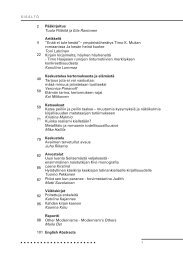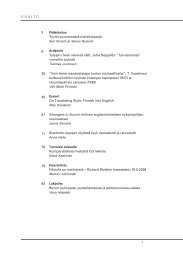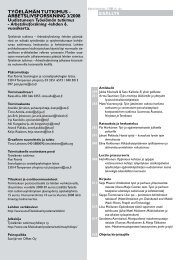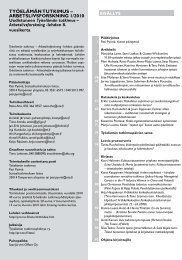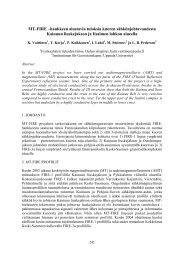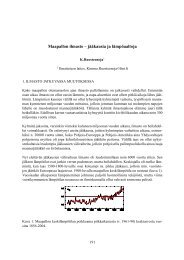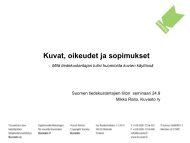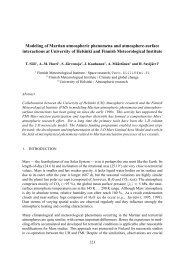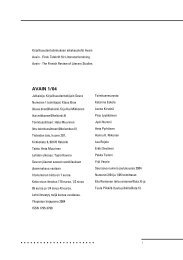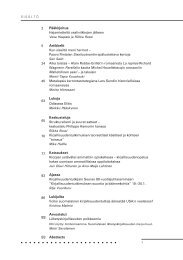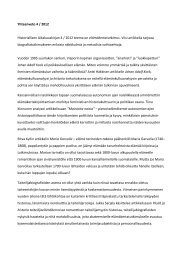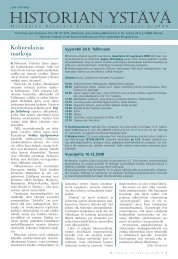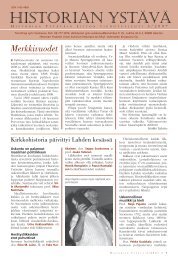TYÃELÃMÃN TUTKIMUS - ARBETSLIVSFORSKNING 2/2008
TYÃELÃMÃN TUTKIMUS - ARBETSLIVSFORSKNING 2/2008
TYÃELÃMÃN TUTKIMUS - ARBETSLIVSFORSKNING 2/2008
Create successful ePaper yourself
Turn your PDF publications into a flip-book with our unique Google optimized e-Paper software.
Työelämän tutkimus – Arbetslivsforskning 2/<strong>2008</strong> (6. vsk.)<br />
katsauksia ja keskustelua<br />
osallistujat itse ottivat koko ajan aktiivisempaa roolia<br />
asian läpiviemiseksi. Hyvin merkittävä tekijä haavityöskentelyn<br />
onnistumisessa oli yrityksen ilmapiirillä. Se<br />
määritteli hyvin pitkälle, millaisiin kehittämishaasteisiin<br />
organisaatiossa oltiin valmiita.<br />
Lattiatason työntekijöiden ideoiden hyödyntämiseksi<br />
innovaatiotoiminnassa on oleellista, että organisaatio<br />
järjestää yksilöitä tukevia elementtejä, jolloin<br />
ajatuksilla on mahdollisuus muuttua toiminnaksi. Muutokset<br />
ovat aina haastavia ja niiden toteutumiseen tulee<br />
varata aikaa. Organisaatiossa täytyy järjestää hyviä<br />
esimerkkejä, jolloin positiiviset huhut alkavat elää ja<br />
kannustavat työntekijöitä osallistumaan yrityksen innovaatiotoimintaan.<br />
Kirjallisuus<br />
Ax t e l l, C., Hol m a n , D., Uns w o r t h , K., Wa l l, T. & Wat e r s o n , P. (2000). Shopfloor innovation: Facilitating the suggestion and<br />
implementation of ideas. Journal of Occupational and Organizational Psychology, 73, 265–285.<br />
Bo s c h m a , R. (2005). Proximity and Innovation: A Critical Assessment. Regional Studies, 39, 61–74.<br />
Fó r s s e n , M. (2002). The life cycle for bottom-up ideas. Case studies of the companies where simulation game method was applied.<br />
Helsinki: HUT Industrial Management and Work and Organizational Psychology Report No 19.<br />
Har m a a k o r p i, V., Tu r a , T. & Ar t im a , E. (2006). Balancing Regional Innovation Policy between Proximity and Distance. Paper<br />
presented at the 5th Proximity Congress, 28– 30 June 2006, Bordeaux, France.<br />
Hus t o n , L. & Sa k k a b, N. (2006). Connect and develop: Inside Procter & Gamble’s new model for innovation. Harvard Business<br />
Review, 84, 58–66.<br />
Mo u lt r i e, J., Ni l s s o n, M., Dis sel, M., Ha n e r , U-E., Ja n s s e n , S. & Va n d e Lu g t, R. (2007). Innovation spaces: Towards for<br />
understanding the role of the physical environment in innovation. Creativity and innovation management, 16, 53–65.<br />
Pa a l a n e n, A. & Ko n s t i-La a k s o, S. (2007). Introducing new methods for organisational innovativeness – the case of innovation<br />
catcher. Paper presented at the 8th International Continuous Innovation NETwork Conference (CINet), 7–11 September<br />
2007, Gothenburg, Sweden.<br />
Pä s s i l ä, A., Pa r j an e n , S. & Pa a l a n e n, A. (2007). Stimulating innovation sensibility. Paper presented at the 10th European<br />
Conference on Creativity and Innovation, 14–17 October 2007, Copenhagen, Denmark.<br />
Va n d e Ven, A. (1980). Problem solving, planning and innovation. Part 2: Speculations for theory and practice. Human Relations,<br />
33, 757–779.<br />
208




